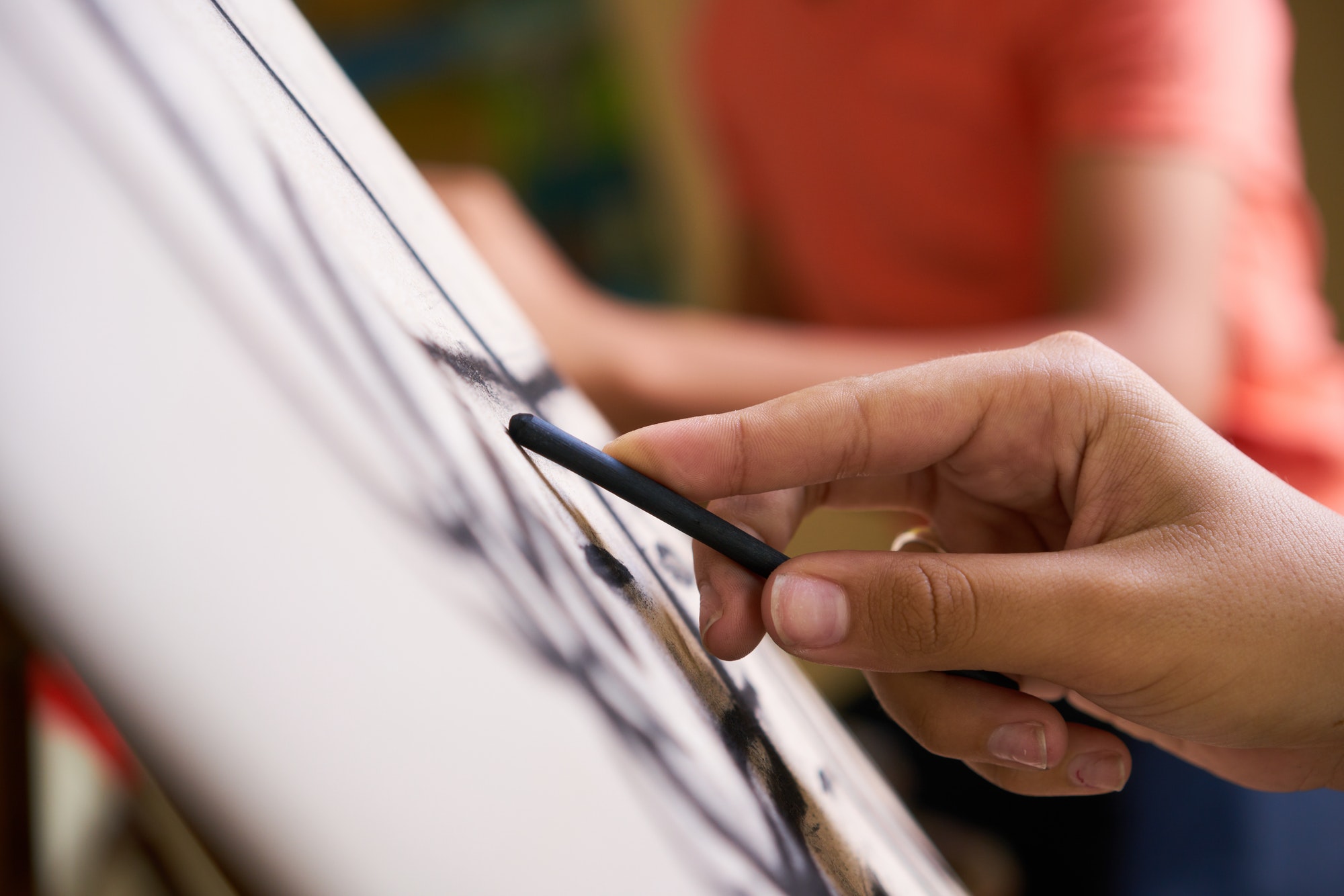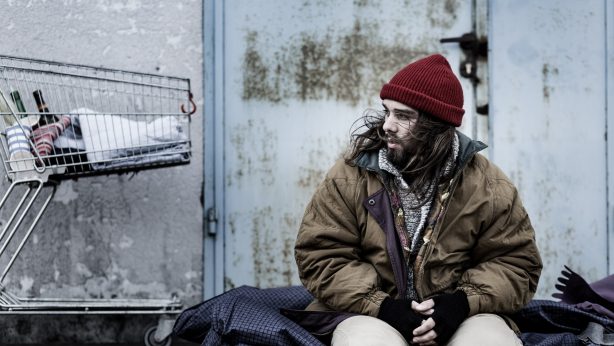Arts Therapy For The Homeless

During World War II, the Dutch artist, Han van Meegeren, sold priceless art masterpieces worth more than half a billion dollars in today’s currency, to wealthy high-ranking Nazi officers. Upon the arrest of Reichsmarschall Hermann Göring for war crimes, a “Vermeer” was discovered in his possession. Traced back to van Meegeren, the artist was subsequently accused of collaborating with the Germans and sentenced to death for treason. In an odd twist during the high-profile trial, Han confessed that the priceless artwork was actually a forgery that he himself had painted. Despite confessing to the scandalous crime, van Meegeren became a national hero, and branded the “world’s greatest art forger,” for duping and selling counterfeit paintings to the Nazis during their occupation of the Netherlands.
How was van Meegeren able to fool so many art connoisseurs? According to the Dutch forger, his success was based on a technique that simulates the look and feel of centuries-old dried oil paint. By cleverly mixing and baking plastics into his pigments, Meegeren’s paintings were able to pass the alcohol and needle test, the primary forensics of the era. Fortunately, today’s art experts use microscopes, micro-niche analysis, and hyper-precise Raman microscopes to expose potential forgeries.
Images have power. They can express hope or convey messages of despair. What image does contemporary society have of the homeless? Is it truthful and authentic or counterfeit and misleading? Unfortunately, forgeries of homelessness hang on many societal hallways. For some, homelessness represents a self-generated situation, highly preventable and easily solved by providing jobs to the “lazy.” Others reduce its images to economic inequalities. The colors and contours of such ill-informed and highly counterfeit icons of one of the nation’s most complicated societal problems must be prudently analyzed. If/when distinguished, the plastics of fraudulent pigments should be quickly exposed and replaced with more honest shades and hues.
According to the Old Testament, when God created mankind He had a vision as to its potential. Fashioned in His image and likeness, humanity is therefore God’s “workmanship,” destined to co-create music, poetry, fiction, dance and other designs of beauty. As the Greek work for “workmanship” has the connotation of being a “work of art,” humanity immediately became a potential masterpiece. When this truth is recognized, each individual can begin the process of refining the sketch of God’s intension on the canvas of their life.
Unfortunately, philosophical, political, and sociological forgers repeatedly replace humanity’s authentic nature and destiny with fraudulent depictions. Like van Meegeren, they have used a variety of techniques to misrepresent the complex manifestations of societal issues, including one of nation’s most critical contexts, namely, homelessness. As a result, apart from falsifying the economic, political, and psychological elements that precipitate the unfortunate privation, society, as well as the homeless themselves, are often duped into “buying” false portrayals.
Homelessness is a complex problem that requires multi-faceted solutions. Many well-intentioned advocates naively believe that what the homeless really need in order to master their difficulties are transportation vouchers, hand-outs, and job opportunities. Others are convinced that the problem can be quickly solved by providing showers, food, and temporary shelter. Still, others are committed to advocating for tax-based social justice antidotes. While such strategies have their merit, root-cause interventions such as art making, appreciation, and art therapy are, regrettably, overlooked. But what exactly is art therapy? How should it be deployed? And what are the expected results of its implementation?
The American Art Therapy Association (AATA), the nation’s leading nonprofit organization for advancing the arts and arts education, describes art therapy as “a human service profession in which clients, facilitated by the art therapist, use art media, the creative process, and the resulting artwork to explore their feelings, reconcile emotional conflicts, foster self-awareness, manage behavior, develop social skills, improve reality orientation, reduce anxiety, and increase self-esteem.” According to AATA, art therapy is an effective treatment for persons experiencing developmental, medical, educational, and social or psychological impairment . . . to improve or restore the functioning and sense of personal well-being.”
According to the American Art Therapy Organization (AATA), art therapy became a formal discipline in the 1940s. The intervention is generally understood as the application of the visual arts and the creative process within a therapeutic relationship to support, maintain, and improve the psychosocial, physical, cognitive and spiritual health of individuals of all ages. More specifically, art can be used to (1) raise public awareness, (2) envision creative and collaborative solutions to societal issues, and (3) help clients express and resolve hidden emotional conflicts.
Implemented in tandem with Housing-First and Rapid-Housing models (see my previous article), art therapy can be a valuable intervention for exposing the varied forgeries of homelessness. Art therapy can help the homeless “re-paint” the current canvas of their lives by exploring feelings, reconciling emotions, managing addictions, developing social skills, reducing anxiety and, thereby, increasing self-esteem. Apart from providing a more honest representation of the issue, the creation and appreciation of art can afford a valuable method for helping the homeless identify problems, regain self-control, and thereby develop a better self-image.
In their article, Homeless Adults Engagement in Art: First Steps Towards Identity, Recovery and Social Inclusion (2011), Yvonne Thomas, Marion Gray, Sue McGinty, and Sally Ebringer delineate the creative techniques of arts therapy as including drawing, painting, collage, coloring, and/or sculpting. According to the authors, the goal of art therapy is to help clients “decode” the nonverbal messages, symbols, and metaphors in their respective art forms through the guidance of a credentialed art therapist. Since the “decoding process” is not about the artistic value of the work but about helping the “artist” find associations between their creative choices and their life, no artistic talent is necessary for creative activity to be empowering, healing, and cathartic. The artwork is merely a “springboard for reawakening memories and telling stories that may reveal messages and beliefs from the unconscious mind.”
In her book, Art Therapy and Health Care (2012), art therapist Cathy Malchiodi outlines three specific aspects that differentiates art therapy from other interventions. Art therapy is: (1) an interpersonal experience in which a therapist facilitates, guides, witnesses and responds to an individual’s art process and art expressions, (2) different than self-help experiences in that there is a helping professional and an individual [family or group] seeking assistance to make changes, and (3) an effective, health-enhancing intervention and form of treatment. Like Thomas et.al, Malchiodi insists that art therapy “has clearly demonstrated that it successfully addresses many somatically-based conditions and . . . is an effective intervention in improving overall quality of life and perceptions of wellness.”
In her series of online commentaries entitled The Ten Coolest Therapy Interventions, Malchiodi additionally outlines ten art therapy strategies that can be tailored to the needs of the homeless. While certainly not exhaustive, her list of art therapy interventions includes: (1) Magazine Photo Collage, (2) Family Sculpture, (3) Mask Making, (4) Group Art, (5) Mandala (Circular) Drawing, (6) Visual Journaling, (7) Visual Metaphor, (8) Third Hand (Mindfulness) Art, (9) Active Imagination, and (10) Expressionism.
Numerous programs and services have emerged that illustrate several of Malchiodi’s art therapy activities to improve the well-being of the homeless. The Manchester Booth Centre, Cafe Art, Art Everywhere, and the Royal Academy Community Art Club are examples of international agencies that help the homeless to rebuild their life and self-esteem through art therapy interventions. H.E.E.A.L. (Hope through Exercise, Energy and Art for Life), Art for the Heart, ArtLifting, Art from the Streets, Streetwise Opera, Cisco Live, Art Therapy Without Borders, Circle of Friends for Mental Health, the Creativity Hour, the Art Therapy Project, HomeFront, Youth Spirit Artworks (YSA), the American Art Therapy Association (AATA), and the National Endowment for the Arts are US-based channels that offer similar programs.
International agencies and guilds that support the use of art therapy include the: (1) Global Alliance for the Arts and Health, (2) International Expressive Arts Therapy Association (IEATA), (3) International Association for Art, Creativity and Therapy (IAACT), (4) International Society for the Psychopathology of Expression & Art Therapy (SIPE), and (5) American Art Therapy Association (AATA). The Art Therapy Department of Mount Mary University in New York is an example of institutions of higher education advancing the therapeutic strategy.
In addition to international organizations, guilds, and creative art therapy programs offered by nonprofit, faith-based, education, and governmental agencies, StreetHeart may be singled out as a distinctive American project that empowers homeless artists to have their art seen, supported, and purchased. The value of StreetHeart lies in its ability to fuse art therapy and technology to connect the underprivileged with the broader community. The organization empowers the homelessness by giving them the opportunity to (1) document their artwork, (2) share it with a larger audience, and (3) receive direct appreciation for their skills. As a consequence, StreetHeart reduces the levels of prejudice that surround the topic of homelessness and, more importantly, improves the self-perception of the homeless themselves. The novel concept, that could easily be replicated in other locations by other agencies, entails a process of five interconnected steps:
- Artwork is documented, electronically captured, and uploaded to a cloud-based repository.
- A social worker verifies and helps artists to set a price for their artwork. Once approved, artwork is displayed on digital screens distributed throughout a locality for the public to view.
- Viewers can provide feedback and/or interact with the artwork by pressing screen buttons. Viewers may also demonstrate their appreciation for the art by sending messages through the program moderator who subsequently sends to the artist.
- If they so choose, viewers can access an online store to see the full gallery of artworks and to purchase them in different formats (mobile screensaver, original, digital print).
- Homeless artists receive a daily text message containing a summary of how many people sent appreciation for their art and how many pieces were sold.
Finally, a more recent study conducted by Barbara Fallon and Kaitlin Schwan entitled Children and Youth Services Review (2018), identifies five general benefits of arts therapy: (1) stress reduction and relaxation, (2) mental health recovery, (3) healing trauma, (4) self-expression & self-discovery, and (5) self-confidence. In particular, the authors recommend 10 ways that the arts can be used to address the individual, systemic, and structural causes of youth homelessness: (1) advocacy, (2) healing & recovery from trauma, (3) public education, (4) building social supports and connections, (5) skill-building (artistic and entrepreneurial) for the new economy, (6) community integration, (7) cultural connections, (8) supports for youth transitioning from homelessness, (9) research mobilization, and (10) career development.
The aforementioned research illustrates that apart from structural and societal privations, homelessness is the result of deep-seeded physical, psychological, and spiritual complications. It is the consequence of a deformed canvas – the result of a fraudulent icon of humanity’s nature – essentially a forgery that sociologists, psychologists, anthropologists, economists, and political scientists have been duped into hanging in the hallways of their respective taxonomies.
Yes, the homeless are suffering from mental illness, addictions, extreme poverty, broken families, and, often, a lack of education. Some are self-deceived, convinced that they are free from the bondages of society. Others are duped into believing that they are “miss-fits,” “bums,” and an “embarrassment” that no one wants to deal with. Heartbreakingly, by accepting the fraudulent pigments that color them as lazy, worthless, criminals, and troublemakers, many victims of homelessness begin to act accordingly.
Contemporary canvases that portray the homeless with such odious brush strokes must be re-painted to more lovingly portray them as valuable human beings – created in the image and likeness of God. Unfortunately, the ontological perspective that all individuals have intrinsic value is currently not promoted as a self-evident truth. While some may, indeed, advocate the need to address the issue from such a theological perspective, their witness is annulled by a simultaneous “not in my back yard” posture.
The Creative Arts Therapies (CATs) of art making, appreciation, and reflection extend the promise of helping the homeless recognize that they are, in truth, valuable human beings, created in the image of God. If the nation desires to leverage these strategies and, thereby, more fully respond to the crises of homelessness in America, leaders of Faith-Based Organizations (FBO) must commit to playing an important role. It is, therefore, the responsibility and privilege of faith-based organizations to help society respond to the complex issue of homelessness by courageously promoting such robust solutions to the public.
Fortunately, a recent study conducted by the Baylor Institute for Studies of Religion, Assessing the Faith-Based Response to Homelessness in America (2017) discovered that “FBO homeless ministries are at the forefront of program innovation and organizational transformation for improving positive outcomes for the homeless individuals and families served.” Furthermore, apart from identifying systemic causes of homelessness, the report notes that faith-based organizations are able to more effectively treat the issue of homelessness “because they recognize humans as spiritual and relational beings, in addition to beings with material needs.” According to the national assessment, FBOs have the unique capacity to help the homeless identify and develop the interdependence of their spiritual, physical, relational, mental-health, and vocational well-being.
In 2013, the Academy Award for Best Documentary was presented to Inocente, an intensely moving film about a 15-year old homeless artist named Inocente who is determined to re-paint the canvas of her colorless situation. Directed by Sean Fine and Andrea Nix, the short documentary was the first crowd funded film to win an Oscar. Despite her bleak past, and her family’s continual shuffle in overcrowded homeless shelters, Inocente dreams of becoming an artist and envisions a world transformed by the colors she glides on her canvases.
As a film, Inocente’s resonance is a result of an inner societal groaning . . . a hunger to make human life sacred again, to uphold the belief that irrespective of race, gender, ethnicity, or social standing, circumstances should not define significance. This, in the end, is what makes humanity a masterful icon of God’s handiwork. Created in His image and likeness, everyone has intrinsic worth, a value that is not determined by pedigree, position, or prosperity, but distinguished by the canvas of love. The implications of responding to the nation’s homeless crisis through such a lens are indeed many and profound.


